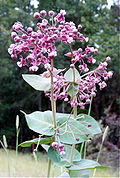- Asclepias
-
"Milkweed" redirects here. For other uses, see Milkweed (disambiguation).
Asclepias Asclepias syriaca showing flowers and latex like sap. Scientific classification Kingdom: Plantae (unranked): Angiosperms (unranked): Eudicots (unranked): Asterids Order: Gentianales Family: Apocynaceae Subfamily: Asclepiadoideae Tribe: Asclepiadeae Subtribe: Asclepiadinae Genus: Asclepias
L.[1]Type species Asclepias syriaca
L.Species See text.
Synonyms Acerates Elliott
Anantherix Nutt.
Asclepiodella Small
Asclepiodora A.Gray
Biventraria Small
Oxypteryx Greene
Podostemma Greene
Schizonotus A.Gray
Solanoa Greene[1]Asclepias syriaca seed pods, Baldwinsville, New York
 Chemical structure of oleandrin, one of the cardiac glycosides
Chemical structure of oleandrin, one of the cardiac glycosides
Asclepias L. (1753), the milkweeds, is a genus of herbaceous perennial, dicotyledonous plants that contains over 140 known species. It previously belonged to the family Asclepiadaceae, but this is now classified as the subfamily Asclepiadoideae of the dogbane family Apocynaceae.
Milkweed is named for its milky juice, which contains alkaloids, latex, and several other complex compounds including cardenolides. Some species are known to be toxic.
Carl Linnaeus named the genus after Asclepius, the Greek god of healing, because of the many folk-medicinal uses for the milkweed plants.
Pollination in this genus is accomplished in an unusual manner. Pollen is grouped into complex structures called pollinia (or "pollen sacs"), rather than being individual grains or tetrads, as is typical for most plants. The feet or mouthparts of flower visiting insects such as bees, wasps and butterflies, slip into one of the five slits in each flower formed by adjacent anthers. The bases of the pollinia then mechanically attach to the insect, pulling a pair of pollen sacs free when the pollinator flies off. Pollination is effected by the reverse procedure in which one of the pollinia becomes trapped within the anther slit.
Asclepias species produce their seeds in follicles. The seeds, which are arranged in overlapping rows, have white silky filament-like hairs known as pappus, silk, or floss. The follicles ripen and split open and the seeds, each carried by several dried pappus, are blown by the wind. They have many different flower colorations.
Contents
Ecology
Milkweeds are an important nectar source for bees and other nectar-seeking insects, and a larval food source for monarch butterflies and their relatives, as well as a variety of other herbivorous insects (including numerous beetles, moths, and true bugs) specialized to feed on the plants despite their chemical defenses.
Milkweeds use three primary defenses to limit damage caused by caterpillars: hairs on the leaves, cardenolide toxins, and latex fluids. Data from a DNA study indicate more recently evolved milkweed species use less of these preventative strategies, but grow faster than older species, potentially regrowing faster than caterpillars can consume them.[2]
Species
Some Asclepias species:
Asclepias albicans Whitestem milkweed Asclepias amplexicaulis Blunt-leaved milkweed 
Asclepias asperula Antelope horns 
Asclepias californica California milkweed Asclepias cordifolia Heart-leaf milkweed 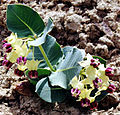
Asclepias cryptoceras Pallid milkweed 
Asclepias curassavica Scarlet milkweed, Tropical milkweed, Bloodroot, Bloodflower, Bastard Ipecacuanha 
Asclepias eriocarpa Woollypod milkweed 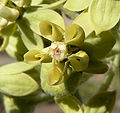
Asclepias erosa Desert milkweed Asclepias exaltata Poke milkweed 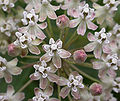
Asclepias fascicularis Narrow leaf milkweed 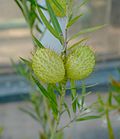
Asclepias fruticosa syn. Gomphocarpus fruticosus swan plant, African milkweed Asclepias humistrata Sandhill milkweed 
Asclepias incarnata Swamp milkweed Asclepias lanceolata Lanceolate milkweed 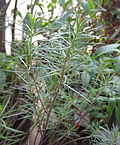
Asclepias linaria Pine needle milkweed Asclepias linearis Slim milkweed 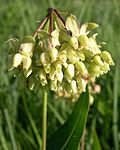
Asclepias meadii Mead's milkweed 
Asclepias nyctaginifolia Mojave milkweed Asclepias obovata Pineland milkweed 
Asclepias physocarpa Balloonplant, Balloon Cotton-bush, Giant Swan Plant, Testicle Tree, Bishop's Balls, Swan Plant 
Asclepias purpurascens Purple milkweed Asclepias quadrifolia Four-leaved milkweed Asclepias rubra Red milkweed Asclepias solanoana Serpentine milkweed 
Asclepias speciosa Showy milkweed 
Asclepias subulata Rush milkweed, Leafless milkweed Asclepias subverticillata Poison milkweed[3] Asclepias sullivantii Sullivant's milkweed 
Asclepias syriaca Common milkweed 
Asclepias tuberosa Indian Paintbrush, Butterfly weed, Pleurisy root Asclepias variegata White milkweed 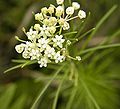
Asclepias verticillata Whorled milkweed Asclepias vestita Woolly milkweed Asclepias vincetoxicum 
Asclepias viridiflora Asclepias welshii Welsh's milkweed Formerly placed here
Some species formerly classified under the Asclepias genus include:
- Calotropis gigantea (L.) W.T.Aiton (as A. gigantea L.)
- Calotropis procera (Aiton) W.T.Aiton (as A. procera Aiton)
- Cynanchum louiseae Kartesz & Gandhi (as A. nigra L.)
- Cynanchum thesioides (Freyn) K.Schum. (as A. sibirica L.)
- Funastrum clausum (Jacq.) Schltr. (as A. clausa Jacq.)
- Gomphocarpus cancellatus (Burm.f.) Bruyns (as A. cancellatus Burm.f. or A. rotundifolia Mill.)
- Gomphocarpus fruticosus (L.) W.T.Aiton (as A. fruticosa L.)
- Marsdenia macrophylla (Humb. & Bonpl. ex Willd.) E.Fourn. (as A. macrophylla Humb. & Bonpl. ex Schult.)
- Marsdenia tenacissima (Roxb.) Moon (as A. tenacissima Roxb.)
- Matelea maritima (Jacq.) Woodson (as A. maritima Jacq.)
- Sarcostemma acidum (Roxb.) Voigt (as A. acida Roxb.)
- Sarcostemma viminale (L.) R.Br. (as A. viminalis (L.) Steud.)
- Telosma cordata (Burm.f.) Merr. (as A. cordata Burm.f.)
- Telosma pallida (Roxb.) Craib (as A. pallida Roxb.)
- Tylophora indica (Burm.f.) Merr. (as A. asthmatica L.f.)
- Vincetoxicum hirundinaria Medik. (as A. vincetoxicum L.)
- Vincetoxicum pycnostelma Kitag. (as A. paniculata Bunge)
- Xysmalobium undulatum (L.) R.Br. (as A. undulata L.)[4]
Uses
The milkweed filaments from the follicles are hollow and coated with wax, and have good insulation qualities. Tests have shown them to be superior to down feathers for insulation. During World War II, over 5,000 t (5,500 short tons) of milkweed floss was collected in the United States as a substitute for kapok. As of 2007, milkweed is grown commercially as a hypoallergenic filling for pillows.[5]
In the past, the high dextrose content of the nectar led to milkweed's use as a source of sweetener for Native Americans and voyageurs.
The bast fibers of some species were also used for cordage.
Milkweed latex contains about 1 to 2% latex, and was attempted as a source of natural rubber by both Germany and the United States during World War II. No record has been found of large-scale success.
Milkweed is a common folk remedy used for the clotting of small wounds and the removal of warts. Milkweed sap is applied directly to the wart several times daily until the wart falls off. Dandelion sap is often used in the same manner.
Milkweed is beneficial to nearby plants, repelling some pests, especially wireworms.
Milkweed also contains cardiac glycoside poisons which inhibit animal cells from maintaining a proper K+, Ca+ concentration gradient.[citation needed] As a result many natives of South America and Africa used arrows poisoned with these glycosides to fight and hunt more effectively. Milkweed is toxic and may cause death when animals consume 10% of their body weight in any part of the plant.[citation needed] Milkweed also causes mild dermatitis in some who come in contact with it.
Milkweed sap is also externally used as a natural remedy for poison ivy.
Being the sole food source of monarch butterfly larvae, the plant is often used in butterfly gardening.
References
- Everitt, J.H.; Lonard, R.L., Little, C.R. (2007). Weeds in South Texas and Northern Mexico. Lubbock: Texas Tech University Press. ISBN 0-89672-614-2
- ^ a b "Taxon: Asclepias L.". Germplasm Resources Information Network. United States Department of Agriculture. 2003-03-13. http://www.ars-grin.gov/cgi-bin/npgs/html/genus.pl?1031. Retrieved 2010-06-27.
- ^ Ramanujan, Krishna (Winter 2008). "Discoveries: Milkweed evolves to shrug off predation". Northern Woodlands (Center for Northern Woodlands Education) 15 (4): 56.
- ^ Asclepias subverticillata (A. Gray) Vail, USDA PLANTS
- ^ "GRIN Species Records of Asclepias". Germplasm Resources Information Network. United States Department of Agriculture. http://www.ars-grin.gov/cgi-bin/npgs/html/splist.pl?1031. Retrieved 2011-02-22.
- ^ Evangelista, R.L. (2007). "Milkweed seed wing removal to improve oil extraction". Industrial Crops and Products 25 (2): 210–217. doi:10.1016/j.indcrop.2006.10.002.
External links
Categories:
Wikimedia Foundation. 2010.




